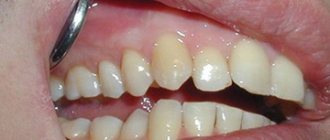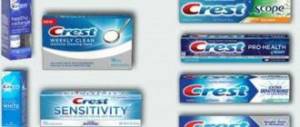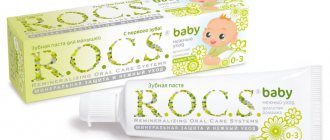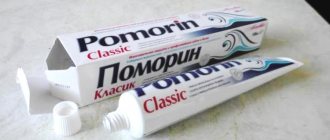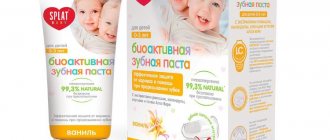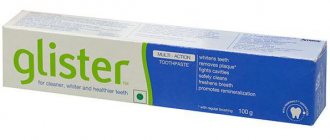Tooth sensitivity is an extremely unpleasant phenomenon, even if it occurs only temporarily (for example, after a teeth whitening procedure). It is impossible to drink a cup of hot tea or, conversely, a glass of cool, refreshing orange juice. If your gums also bleed, then even mandatory hygiene procedures in the morning and evening turn into torture.
Pathological sensitivity of teeth requires treatment, and usually patients do not delay visiting a doctor, as they experience great discomfort and understand the seriousness of the situation. But while the treatment is being carried out and the result is not achieved, you still need to take care of your teeth at home.
And then, for prevention, you will need a special, gentle product for sensitive teeth, which would not injure defective enamel and gums and at the same time effectively clean them and protect them from caries.
Sensodyne instant effect toothpaste is exactly the right product for sensitive teeth, which in a complex solves many problems at once. There are several different types of toothpaste for a variety of needs, all of them different in their composition and healing properties. But they have one thing in common - always a good, truly instant effect and excellent quality, tested by millions of patients.
Description
If you experience short-term sharp pain when eating hot or cold food and drinks, when brushing your teeth, or even when breathing cold air, it may be tooth sensitivity. Tooth sensitivity can occur when hard tooth enamel wears away, exposing the softer, sensitive dentin underneath. Sensodyne® Restore & Protect detects sensitive areas of the teeth. NovaMin® begins to act upon contact with saliva and adheres to exposed dentin, forming a protective layer that helps restore vulnerable areas.
Kinds
There are several types of Sensodyne, each of which combats hypersensitivity, but differ in different compositions and can solve associated dental problems (additional cleansing, enhanced formula with fluoride, gum protection, and others).
Classic Sensodyne
Designed for daily dental care. Its distinctive feature is the absence of fluoride in the composition, so you can use this paste every day without interruption.
It carefully cleanses plaque, freshens breath and strengthens enamel. Classic Sensodyne can also be used by children from 6 years of age, the amount of paste for one-time brushing of children’s teeth is about the size of a pea. It is recommended to brush your teeth 2-3 times a day.
Sensodyne F
A paste containing fluoride (sodium fluoride), which perfectly protects against caries. Sensodyne F reduces sensitivity already on the second day of use.
This paste is low abrasive and cleans very gently, so it is suitable for daily use by people with and without hyperesthesia (hypersensitivity).
Comprehensive protection (Sensodyne Total Care)
A paste whose action is aimed at treating hypersensitivity and concomitant inflammatory processes in the gums. The composition includes a whole complex of active substances: fluoride, potassium chloride (blocks nerve pain impulses), vitamin E and B5 (have an anti-inflammatory effect on the gums), zinc citrate (has an antibacterial effect).
It is recommended to use the paste for at least two months to achieve lasting results.
Acid Erosion Protection (Sensodyne ProNamel)
This paste effectively restores areas of enamel damaged by acidic conditions. It also contains fluoride, which strengthens enamel, and potassium chloride, which reduces pain sensitivity.
Additionally, Sensodyne Pro Namel protects against the effects of acids on enamel. Also suitable for daily cleaning due to its gentle action. The paste has an option for children (for children), which can be used from 6 years old.
Sensodyne Whitening whitening paste
It can gently whiten teeth (by 1-2 tones), remove age spots and protect against the appearance of new ones. It is ideal for people who have undergone professional whitening to maintain white teeth. Sensodyne Whitening gently cleanses enamel, relieves sensitivity and is suitable for daily use.
Sensodyne Gentle whitening
Whitens teeth very gently and leaves a protective film on the surface that prevents the enamel from darkening. Designed for daily use. In addition to preserving the whiteness of teeth, it eliminates sensitivity, protects against caries, and freshens breath.
Sensodyne Instant effect Rapid Action
It has the fastest effect on tooth sensitivity. To relieve painful sensations, the paste needs to be rubbed in with your finger for about a minute; this procedure will create a protective shell on the tooth from irritants.
You need to brush your teeth with this paste for 3 minutes twice a day, which will provide a noticeable reduction in sensitivity, protection against caries, and restoration of the enamel layer.
Instructions for use Sensodyne
Instructions for use of Sensodyne include the following steps:
- Apply a pea-sized amount of paste over your toothbrush.
- Distribute it evenly over the surface of the teeth and gums.
- Brush your teeth for 2-3 minutes.
- Rinse your mouth thoroughly with water.
Some people complain about the lack of results from using Sensodyne. This can indicate only one thing - the presence of a serious disease. The product is not intended for the treatment of severe dental pathologies, so before using it you should consult your dentist and carefully read the instructions.
Sensodyne instant effect
This toothpaste, as the name “instant effect” already implies, gives noticeable results after the first use. This is the type that dentists recommend for severe pain. When used, the instant effect toothpaste forms a protective layer on the surface of the teeth that protects hypersensitive enamel from irritants.
It can be used after treatment as a pain reliever by rubbing a small amount onto the tooth for one minute. After this, sensitive teeth are not afraid of hot tea, sour juice, or sweet cake.
In addition, the paste has a wound-healing and anti-inflammatory effect if there are wounds and abrasions in the mouth, which means that it is very well suited for oral care for stomatitis or gingivitis. This paste is also not recommended for use by children under 12 years of age; after using it, you should rinse your mouth thoroughly.
How to choose a toothpaste for sensitive teeth -
Toothpastes for relieving tooth sensitivity (hypersthesia) have specific characteristics. Firstly, toothpaste for sensitive teeth usually has a fairly low abrasiveness within the RDA range of 25 to 35 (RDA - abrasiveness index). For example, for ordinary therapeutic and prophylactic toothpastes the RDA index is 75, and for whitening pastes it is usually 100-120.
The second important point to pay attention to is the active components. Different manufacturers use ingredients that are different from each other, which have different mechanisms for reducing tooth sensitivity, and as a result, have different effectiveness and different speed of onset of effect. Based on the mechanism of action, the following groups of components can be distinguished...
Active components in toothpastes for sensitive teeth -
- Potassium nitrate, potassium chloride - these components block the transmission of nerve impulses.
The transmission of nerve impulses is based on the exchange of potassium ions (located inside nerve cells) with sodium ions located outside the nerve. By increasing the concentration of potassium ions around the nerve endings, we disrupt this exchange, which leads to the absence of pain in the teeth - in response to thermal and mechanical stimuli. The advantage of these components is that the effect of their use develops very quickly. However, the result will last as long as you use them. Thus, potassium nitrate and chloride can quickly relieve pain, but they do not eliminate the very cause of hyperesthesia.
- Fluorides, strontium chloride, zinc citrate, hydroxyapatite - these components affect precisely the cause of the development of dental hypersensitivity - the accelerated movement of fluid in the dentinal tubules, which leads to irritation of the nerve endings.
Fluoride compounds (sodium fluoride, aminofluoride, monofluorophosphate), strontium chloride, zinc citrate, hydroxyapatite - all of them clog the dentinal tubules, preventing the movement of fluid in them. In addition, strontium chloride also promotes the deposition of replacement dentin and the compaction of its structure, which also helps reduce hypersensitivity. However, the downside of all these components is that the effect from their use develops more slowly than from the use of potassium nitrate or potassium chloride.
- Arginine and calcium carbonate combination - a combination of Arginine (an amino acid) and calcium carbonate in toothpaste - is also very effective in treating dental hypersensitivity.
Arginine facilitates the deposition of a layer of calcium carbonate on the surface of the teeth, which in turn stimulates the deposition of phosphates on the surface of exposed dentin and in the dentinal tubules, contributing to their clogging and reducing the movement of fluid in them. However, although it reduces sensitivity well, it does not solve the problem of demineralization of enamel and dentin. It should be noted here that the layer of calcium carbonate with arginine will be inactive, and calcium from this layer will not penetrate into the hard tissues of the teeth. This distinguishes arginine carbonate pastes from pastes with fluorides, after the use of which an active layer of calcium fluoride (CaF2) is created on the tooth surface. In addition to the fact that CaF2 also clogs the dentinal tubules on the surface of exposed dentin, calcium and fluoride from this layer are able to penetrate into the hard tissues of the teeth, strengthening them.
Conclusions -
Precisely because some components are capable of providing an immediate effect, while others (although their effect develops slowly, they eliminate precisely the cause of pain) - most toothpastes for sensitivity are made with a combined composition. Where potassium nitrate quickly relieves pain, and fluorides, hydroxyapatite, strontium chloride, or a combination of arginine and calcium carbonate clog exposed dentinal tubules.
However, there are also effective monocomponent products for use at home. Such products contain a very high concentration, usually of only one component, for example, potassium nitrate or sodium fluoride. In this way, they resemble professional means for reducing sensitivity that dentists use in their work. Examples of such gels are PRESIDENT Sensitive Plus and Colgate® Duraphat. How they can help you - read below.
Sensodyne F – fluorine-containing
This remedy is prescribed both for treatment of lack of fluoride in the body and for prevention. If tooth enamel is very sensitive and prone to the formation of carious spots and cavities, this is the optimal toothpaste. The effect is felt after 2-3 applications. Painful sensations become less, and the enamel becomes harder and stronger.
Moreover, this toothpaste does not contain abrasive particles - it gently removes plaque even in hard-to-reach places and thereby provides additional protection against caries. According to studies, sensitivity and pain are reduced by 40% with regular use of Sensodyne F.
Sensodyne for acid erosion
The composition of this type of paste is unique: already during brushing, tooth enamel is remineralized, areas affected by erosion are filled with active substances and restored. Fluoride increases the hardness of tooth enamel and makes it less vulnerable to the aggressive effects of acids. Potassium nitrate reduces tooth sensitivity, and the neutral pH level prevents an increase in the acidity of the environment in the oral cavity.
This product does not contain sodium lauryl sulfate and can be used daily. A special paste of this type is produced for children, marked “for children”. Dentists recommend it for dental care for children over 6 years old; the product provides maximum protection against caries, freshens breath and has a slight whitening effect.
Those who have tried this paste on themselves are usually very satisfied and never return to their previous products. The paste costs a little more than the popular Colgate and Aquafresh, but is much cheaper than professional and medicinal products. At the same time, the effect when using it is no worse. Therefore, if you are concerned about tooth sensitivity, bleeding gums, or are looking for a gentle means to cleanse your child’s teeth, Sensodyne paste is ideal for you.
It is important to know:
Classic Sensodyne
This paste is ideal for sensitive teeth; it does not contain fluoride, so it can be used for everyday care, including for children's teeth. It freshens breath for a long time, effectively removes plaque and prevents the formation of tartar, cares for sensitive gums and prevents their bleeding.
Sensodyne toothpaste - types and composition
Sensodyne toothpaste for sensitive teeth is produced by the British concern GlaxoSmithKline. This pharmaceutical manufacturing company is known all over the world. In addition to its own 27 laboratories for research and development of new products and 70 factories for their manufacture, the company has branches in 115 countries.
Toothpaste for sensitive teeth Sensodyne is one of the most famous products of this brand. According to statistics, this product occupies a leading position in the world among toothpastes intended for the care of sensitive teeth.
At the moment, the company's products are represented by the following line:
- Classic toothpaste.
- Toothpaste with a high fluoride content.
- Toothpaste for comprehensive protection of sensitive teeth and gums.
- Whitening toothpaste.
- Toothpaste that protects enamel from oxidation.
- Toothpaste with immediate effect and long-lasting action to protect against caries.
Despite the fact that the properties of each paste are different, the basic composition of all these oral care products is identical. The components are selected so that any paste freshens breath, removes plaque, destroys bacteria and strengthens tooth enamel and gums. In addition, each of them solves a specific problem in the oral cavity - lack of fluoride, acid erosion on enamel, susceptibility to caries, etc.
- Sodium fluoride. This substance destroys bacteria and helps restore dental tissue where it has been slightly damaged.
- Potassium nitrate. This component affects nerve endings and reduces tooth sensitivity, providing an immediate effect even in severe pain.
- Fluorine. Maintains an optimal acidic environment in the oral cavity and additionally protects teeth from caries.
- Plant extracts. Extracts of medicinal herbs and plants enhance the effect of chemical components, freshen breath and have additional antiseptic and anti-inflammatory effects.
Various excipients included in the composition of the pastes provide the desired consistency, taste, smell, and qualities of the toothpaste, facilitating its convenient dosage, distribution on the tooth surface and foaming.
To choose a toothpaste that provides optimal dental care and eliminates the current problem, it is worth taking a closer look at the composition and features of each type.
Whitening Sensodyne
This type of paste, like the classic one, freshens breath, eliminates plaque, prevents the development of inflammation and significantly reduces the painful reaction of teeth to temperature, chemical or mechanical stimuli. But the paste contains fluoride, which strengthens tooth enamel, and special substances that gently whiten it, eliminating dark spots and pigmentation.
After using this product, a protective film is formed on the surface of the teeth, which prevents staining substances from penetrating into the tooth tissue and keeps them white and shiny. Whitening Sensodyne is often recommended by dentists for home care after a professional whitening procedure to consolidate and enhance the resulting effect.
But this type of paste cannot be used by children under 12 years of age; in addition, sometimes its components cause irritation of the mucous membranes.
